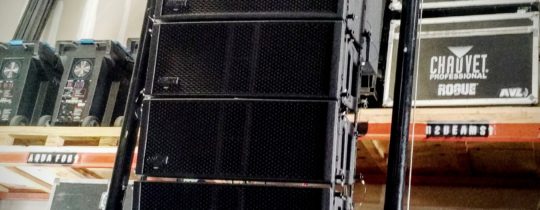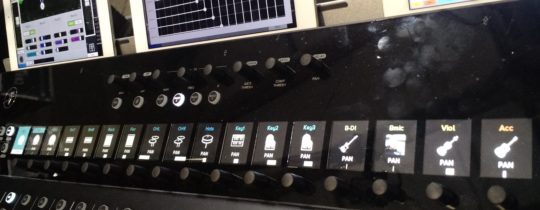
First Look – EAW RADIUS Speaker Line
October 11, 2016A couple weeks ago, I had the chance to attend a demo of new EAW and Mackie offerings featuring Dante connectivity. Mackie was showing their brand new AXIS digital mixing system, and EAW, the new RADIUS speaker line. You can read my impressions of the EAW speakers here. I was impressed!
I promised to share my thoughts on the Mackie AXIS System as well, so here we go.
Many will already be familiar with the “guts” of the system, as this is an expansion of the Mackie DL32R digital mixer that uses the Mackie “Master Fader” app for iPad to provide control (just like Mackie siblings the DL1608 and DL806). AXIS takes the DL32R to the next level with the addition of the brand new DC16 control surface and Dante interconnectivity for audio and control.
The addition of the DC16 creates a complete 32 mic preamp (plus some local inputs) system package with everything you expect in a digital mixing console, including remote control of the ONYX preamps in the DL32R stage box. Since connectivity is via Dante, audio and control are both sent over one CAT5e/6/7 cable.
At first glance, the DC16 conjures up thoughts of the AVID S3L system. There is a certain visual resemblance in the clean, simple layout of both 17 fader desks. That’s pretty nice company when you consider the AXIS is about a third the price of the AVID configured with the same input channel count. Part of that initial resemblance is the lack of any sort of inbuilt “main” touchscreen. The Mackie AXIS System addresses the screen issue by allowing you to connect up to three iPads to the DC16, including providing a slot for mounting them, and USB jacks for providing power and rock-solid connectivity so that they act as a 3-touch screen bridge. The console detects when the iPads are connected and in place to immediately address them. Of course you can grab an iPad and leave the console for remote wireless control of the system at any time. Drop it back on the console and it automatically returns to the screen you were using when you pulled it.
For our purposes today, I won’t cover every spec and feature – you can read all the details here, at the AXIS web page, or explore the Mackie AXIS introduction and training videos by registering at this link. I do want to hit a few key points though.
The system – in its current incarnation – provides 36 input channels (32 mic/line preamps), 18 audio outputs derived from 28 busses, and 14 aux sends. There are 17 faders, including Master. Each of the 16 input faders feature a substantial TFT 160x128px backlit screen, plus there are 10 more located at various places on the desk, for a total of 26. These are large enough to provide quite a bit of local data at each screen. As you would expect, there are a number of recording and playback options, including 32×32 multi-track and 2-track in and out options via several digital options, plus AES in/out. Wireless control (integrated in the console) abounds. You have the three iPads running Master Control that can be hardwired at the console, but you also have available up to 20 unique wireless iOS devices connected for monitor mixing, etc. Each device can be set with its own parameter access level for security. The AXIS system comes equipped with 6 DCA (VCA) groups, 6 mute groups, 6 Matrix sends, 6 audio sub groups, and 3 internal stereo effects processors. There are 6-segment ladder style LED meters per channel, and 3 segment GR meters for monitoring channel processing.
With three iPads serving as touch screens, Mackie did not see the need to provide too many physical encoders. This also helps maintain the DC16’s clean aesthetic. There are plenty of buttons for mute, cue, select, and console function/layout recall. There are 27 rotary encoders. Eight encoders are associated with the currently selected channel for EQ and processing control as well as gain and HPF levels. Three provide level control of phones, monitor, and talkback mic. The remainder control whatever purpose is required based on the current layout.
Spacing on the channel faders is exceptional, plus The DC16 boasts all 100mm Alps faders, with recall (of course). Kudos to Mackie for not trying to reinvent the wheel! Channel layout options are almost endless – you can place/group inputs on the faders however you see fit to make your mixing experience as easy and intuitive as possible. Nice.
As a little aside; one thing I was told at the demo is that Mackie is no longer racing other manufacturers to the bottom in the equipment pricing game. This is great news. If your only criteria for purchasing audio equipment is price, you will need to look elsewhere, and (I would add) expect to be disappointed. What I saw at the demo is a product that has had considerable thought put into design, function, ergonomics, practical uses…you name it.
I have to say though, with all that consideration put into the design, and with an obvious eye to creating a professional product, as opposed to some “me-too MI store” digital mixer, I am still left a bit confused by the Mackie AXIS System. This is about a $6000 system, with a max mic/line input count of 32. We could all assumethat Mackie will find a way to push that up in either software or hardware updates, or both, but right now, that is it. There are a LOT of sub-$10k options these days that can offer a stage box and even Dante, plus handle a greater total mix channel count. Most will have more VCAs, more internal effects (with more included options and flexibility) and most INCLUDE a built-in main touchscreen PLUS iPad and/or PC support. The Yamaha TF series, Soundcraft Si series, and even the Midas M32 at least equal the Mackie’s spec sheet for less money. None of these are slouches when it comes to sound quality. Step up a bit in price and you are looking at Digico S21, A&H GLD series, and Yamaha QL. Add to that the fact that most of these have a high LOCAL channel count, plus support remote stage boxes…which brings me to another question mark.
The AXIS system is basically a DL32R with the addition of the DC16 surface and Dante. The mix engine still resides in the DL32R. The DC16 alone cannot pass any audio. Essentially, it brings to the table a tactile interface and iPod dock (times three). Yet the system cost is more than triple that of the DL32R alone. Now if adding the DC16 provided another (let’s just say) 8-16 mic pres, and made the system a 48×16 or 48×24 with at least 4 internal effects, I would think Mackie really had something going on at this price point. But in its current state, that is not the case. Sure, you can add more DL32 boxes for under $2000 each, but you can only access and mix up to 32 channels at one time.
Don’t misunderstand me. The format, size and channel count will be perfect for many applications, but the price point is at the high-end of a large portion of the market seeking this size digital console. While I applaud Mackie for not trying to go head to head with – OK, I’ll just say it – the Behringer X32, there are certainly other solutions that fall between these two price points with at least the same feature count as the Mackie – and sometimes more. And most are not annoyingly complicated to setup, like the X32.
Really, I WANT to like the AXIS system. It looks and feels great. The ergos will be VERY appealing to many. Having three touch screens (iPads), plus the on-surface dedicated controls and TFT panels is really nice. Except, that means you have to BUY three iPads – or even an iPad Pro if you want the larger main touch screen. That means more cash out. It also means you are 100% reliant on each of those separate computers working flawlessly. Personally, the Master Fader app is not my favorite. Little things bug me, like how easy it is to touch something inadvertently and change your screen mid-operation. Sure, you can jump right back, but I have done this more than once. I also prefer how the Yamaha and A&H (for example) apps display fine details – in particular how they provide a specific dB level or other key number right along with the graphic representation of each function’s level on screen – which Master Fader does not. If you want to know the exact gain level, or compression ratio, or threshold level in dBs in Master Fader, you have to touch that function for the number to display at the top of the screen. The others list the number right next to the graphic representation for each and every function. I am sure this fits into Mackie’s minimalist design appeal – helping make screens optically pleasing and uncluttered. As the guy using the tools, I really prefer to see those details at a glance though. Maybe that’s just me.
With the AXIS system, Mackie is making every attempt to take on more expensive consoles, not cheaper. They feel that they are bringing something new, different – even better – to the table. This is certainly a uniquely Mackie product. It is original and attractive. Is it a viable option for you? Is it better than other, more expensive options? Is it so much better than some less expensive options that you feel you should spend the extra money to get one? Only time will tell how you, the Pro-Audio Consumer answers these questions, and only then will we see if Mackie has a hit or a bust.
#Mackie #AXIS #MackieAXISsystem

